SLOS992 December 2017 TPA3156D2
PRODUCTION DATA.
- 1 Features
- 2 Applications
- 3 Description
- 4 Revision History
- 5 Pin Configuration and Functions
- 6 Specifications
-
7 Detailed Description
- 7.1 Overview
- 7.2 Functional Block Diagram
- 7.3
Feature Description
- 7.3.1 Gain Setting and Master and Slave
- 7.3.2 Input Impedance
- 7.3.3 Startup and Shutdown Operation
- 7.3.4 PLIMIT Operation
- 7.3.5 GVDD Supply
- 7.3.6 BSPx AND BSNx Capacitors
- 7.3.7 Differential Inputs
- 7.3.8 Device Protection System
- 7.3.9 DC Detect Protection
- 7.3.10 Short-Circuit Protection and Automatic Recovery Feature
- 7.3.11 Thermal Protection
- 7.3.12 Device Modulation Scheme
- 7.3.13 Efficiency: LC Filter Required with the Traditional Class-D Modulation Scheme
- 7.3.14 Ferrite Bead Filter Considerations
- 7.3.15 When to Use an Output Filter for EMI Suppression
- 7.3.16 AM Avoidance EMI Reduction
- 7.4 Device Functional Modes
- 8 Applications and Implementation
- 9 Power Supply Recommendations
- 10Layout
- 11Heat Sink Used on the EVM
- 12Device and Documentation Support
- 13Mechanical, Packaging, and Orderable Information
Package Options
Mechanical Data (Package|Pins)
- DAD|32
Thermal pad, mechanical data (Package|Pins)
- DAD|32
Orderable Information
6 Specifications
6.1 Absolute Maximum Ratings
over operating free-air temperature range (unless otherwise noted)(1)| MIN | MAX | UNIT | ||
|---|---|---|---|---|
| Supply voltage, VCC | PVCC, AVCC | –0.3 | 30 | V |
| Input voltage, VI | INPL, INNL, INPR, INNR | –0.3 | 6.3 | V |
| PLIMIT, GAIN / SLV, SYNC | –0.3 | GVDD+0.3 | V | |
| AM0, AM1, AM2, MUTE, SDZ, MODSEL | –0.3 | PVCC+0.3 | V | |
| Slew rate, maximum(2) | AM0, AM1, AM2, MUTE, SDZ, MODSEL | 10 | V/ms | |
| Operating free-air temperature, TA | –40 | 85 | °C | |
| Operating junction temperature , TJ | –40 | 150 | °C | |
| Storage temperature, Tstg | –40 | 125 | °C | |
(1) Stresses beyond those listed under absolute maximum ratings can cause permanent damage to the device. These are stress ratings only, and functional operation of the device at these or any other conditions beyond those indicated under recommended operating conditions is not implied. Exposure to absolute-maximum-rated conditions for extended periods can affect device reliability.
(2) 100-kΩ series resistor is required if maximum slew rate is exceeded.
6.2 ESD Ratings
| VALUE | UNIT | |||
|---|---|---|---|---|
| V(ESD) | Electrostatic discharge | Human-body model (HBM), per ANSI/ESDA/JEDEC JS-001(1) | ±2000 | V |
| Charged-device model (CDM), per JEDEC specification JESD22-C101(2) | ±500 | |||
(1) JEDEC document JEP155 states that 500-V HBM allows safe manufacturing with a standard ESD control process.
(2) JEDEC document JEP157 states that 250-V CDM allows safe manufacturing with a standard ESD control process. .
6.3 Recommended Operating Conditions
over operating free-air temperature range (unless otherwise noted)| MIN | NOM | MAX | UNIT | ||||
|---|---|---|---|---|---|---|---|
| VCC | Supply voltage | PVCC, AVCC | 4.5 | 26 | V | ||
| VIH | High-level input voltage | AM0, AM1, AM2, MUTE, SDZ, SYNC, MODSEL | 2 | V | |||
| VIL | Low-level input voltage | AM0, AM1, AM2, MUTE, SDZ, SYNC, MODSEL | 0.8 | V | |||
| VOL | Low-level output voltage | FAULTZ, RPULL-UP = 100 kΩ, PVCC = 26 V | 0.8 | V | |||
| IIH | High-level input current | AM0, AM1, AM2, MUTE, SDZ, MODSEL (VI = 2 V, VCC = 18 V) |
50 | µA | |||
| RL(BTL) | Minimum load Impedance | Output filter: L = 10 µH, C = 680 nF | 3.2 | 4 | Ω | ||
| RL(PBTL) | Output filter: L = 10 µH, C = 1 µF | 1.6 | 2 | ||||
| Lo | Output-filter Inductance | Minimum output filter inductance under short-circuit condition | 1 | µH | |||
6.4 Thermal Information
| THERMAL METRIC(1) | TPA3156D2 | UNIT | |
|---|---|---|---|
| DAD(2) | |||
| 32 PINS | |||
| RθJA | Junction-to-ambient thermal resistance | N/A | °C/W |
| RθJC(top) | Junction-to-case (top) thermal resistance | 1.2 | °C/W |
| ψJT | Junction-to-top characterization parameter | 1.2 | °C/W |
| ψJB | Junction-to-board characterization parameter | 21 | °C/W |
(1) For more information about traditional and new thermal metrics, see the IC Package Thermal Metrics application report, SPRA953.
(2) For the PCB layout please see the TPA3156D2EVM user guide.
6.5 DC Electrical Characteristics
TA = 25°C, AVCC = PVCC = 12 V to 24 V, RL = 4 Ω, fs = 400 kHz, low idle-loss mode(unless otherwise noted)| PARAMETER | TEST CONDITIONS | MIN | TYP | MAX | UNIT | ||
|---|---|---|---|---|---|---|---|
| | VOS | | Class-D output offset voltage (measured differentially) | VI = 0 V | 1.5 | 5 | mV | ||
| ICC | Quiescent supply current | SDZ = 2 V, With load and filter, PVCC = 12 V | 15 | mA | |||
| SDZ = 2 V, With load and filter, PVCC = 24 V | 23 | ||||||
| ICC(SD) | Quiescent supply current in shutdown mode | SDZ = 0.8 V, With load and filter, PVCC = 12 V | 20 | µA | |||
| SDZ = 0.8 V, With load and filter, PVCC = 24 V | 30 | ||||||
| rDS(on) | Drain-source on-state resistance, measured pin to pin | PVCC = 21 V, Iout = 500 mA, TJ = 25°C | 90 | mΩ | |||
| G | Gain (BTL) | R1 = 5.6 kΩ, R2 = Open | 19 | 20 | 21 | dB | |
| R1 = 20 kΩ, R2 = 100 kΩ | 25 | 26 | 27 | ||||
| R1 = 39 kΩ, R2 = 100 kΩ | 31 | 32 | 33 | dB | |||
| R1 = 47 kΩ, R2 = 75 kΩ | 35 | 36 | 37 | ||||
| G | Gain (SLV) | R1 = 51 kΩ, R2 = 51 kΩ | 19 | 20 | 21 | dB | |
| R1 = 75 kΩ, R2 = 47 kΩ | 25 | 26 | 27 | ||||
| R1 = 100 kΩ, R2 = 39 kΩ | 31 | 32 | 33 | dB | |||
| R1 = 100 kΩ, R2 = 16 kΩ | 35 | 36 | 37 | ||||
| ton | Turn-on time | SDZ = 2 V | 40 | ms | |||
| tOFF | Turn-off time | SDZ = 0.8 V | 2 | µs | |||
| GVDD | Gate drive supply | IGVDD < 200 µA | 5.1 | 5.6 | 6.3 | V | |
| VO | Output voltage maximum under PLIMIT control | V(PLIMIT) = 2 V; VI = 1 Vrms | 6.75 | 8.2 | 8.75 | V | |
6.6 AC Electrical Characteristics
TA = 25°C, AVCC = PVCC = 12 V to 24 V, RL = 4 Ω (unless otherwise noted)| PARAMETER | TEST CONDITIONS | MIN | TYP | MAX | UNIT | |
|---|---|---|---|---|---|---|
| KSVR | Power supply ripple rejection | 200 mVPP ripple at 1 kHz, Gain = 26 dB, Inputs AC-coupled to GND |
–70 | dB | ||
| PO | Continuous output power | THD+N = 10%, f = 1 kHz, PVCC = 14.4 V, Load = 4Ω | 25 | W | ||
| THD+N = 10%, f = 1 kHz, PVCC = 21 V, Load = 8 Ω | 50 | |||||
| THD+N = 10%, f = 1 kHz, PVCC = 24 V, Load = 4 Ω | 70 | |||||
| THD+N | Total harmonic distortion + noise | VCC = 21 V, f = 1 kHz, PO = 15 W (half-power) | 0.1% | |||
| Vn | Output integrated noise | 20 Hz to 22 kHz, A-weighted filter, Gain = 20 dB | 65 | µV | ||
| –80 | dBV | |||||
| Crosstalk | VO = 1 Vrms, Gain = 20 dB, f = 1 kHz | –100 | dB | |||
| SNR | Signal-to-noise ratio | Maximum output at THD+N < 1%, f = 1 kHz, Gain = 20 dB, A-weighted | 102 | dB | ||
| fOSC | Oscillator frequency | AM2=0, AM1=0, AM0=0 | 376 | 400 | 424 | kHz |
| AM2=0, AM1=0, AM0=1 | 470 | 500 | 530 | |||
| AM2=0, AM1=1, AM0=0 | 564 | 600 | 636 | |||
| AM2=0, AM1=1, AM0=1 | 940 | 1000 | 1060 | |||
| AM2=1, AM1=0, AM0=0 | 1128 | 1200 | 1278 | |||
| AM2=1, AM1=0, AM0=1 | 282 | 300 | 318 | |||
| AM2=1, AM1=1, AM0=0 | 282 | 300 | 318 | |||
| Modulation scheme Fixed in 1SPW Mode | ||||||
| AM2=1, AM1=1, AM0=1 | Reserved | |||||
| Thermal trip point | ≥150 | °C | ||||
| Thermal hysteresis | 15 | °C | ||||
| Over current trip point | 10 | A | ||||
6.7 Typical Characteristics
fs = 400 kHz, Ultra Low Idle Loss Mode, TPA3156D2EVM Tested With AP2722. (unless otherwise noted)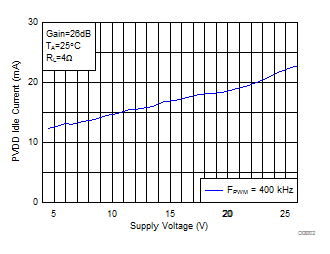 Figure 1. Idle Current vs PVCC
Figure 1. Idle Current vs PVCC
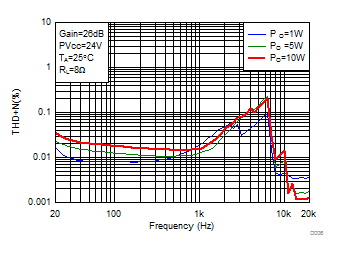 Figure 3. Total Harmonic Distortion + Noise (BTL) vs Frequency
Figure 3. Total Harmonic Distortion + Noise (BTL) vs Frequency
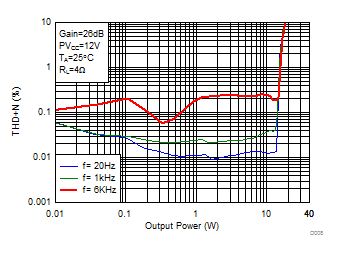 Figure 5. Total Harmonic Distortion + Noise (BTL) vs Output Power
Figure 5. Total Harmonic Distortion + Noise (BTL) vs Output Power
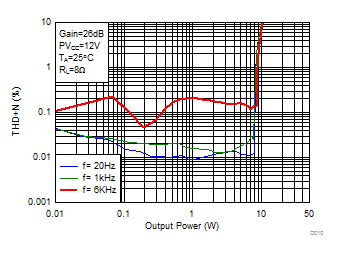 Figure 7. Total Harmonic Distortion + Noise (BTL) vs Output Power
Figure 7. Total Harmonic Distortion + Noise (BTL) vs Output Power
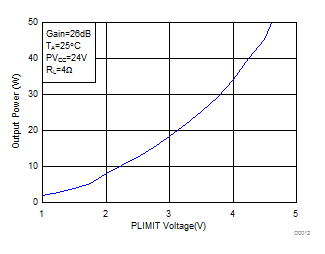 Figure 9. Output Power (BTL) vs Plimit Voltage
Figure 9. Output Power (BTL) vs Plimit Voltage
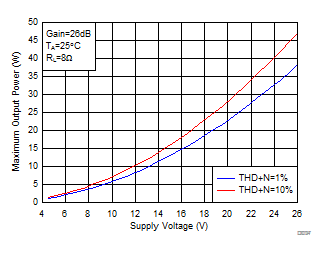 Figure 11. Maximum Output Power (BTL) vs Supply Voltage
Figure 11. Maximum Output Power (BTL) vs Supply Voltage
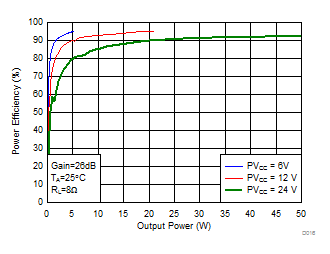 Figure 13. Power Efficiency (BTL) vs Output Power
Figure 13. Power Efficiency (BTL) vs Output Power
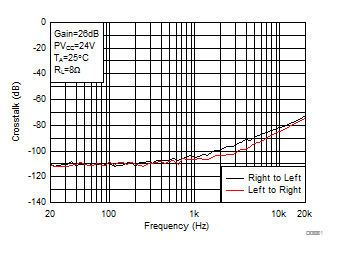 Figure 15. Crosstalk vs Frequency
Figure 15. Crosstalk vs Frequency
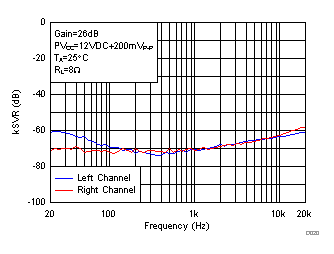 Figure 17. Supply Ripple Rejection Ratio (BTL) vs Frequency
Figure 17. Supply Ripple Rejection Ratio (BTL) vs Frequency
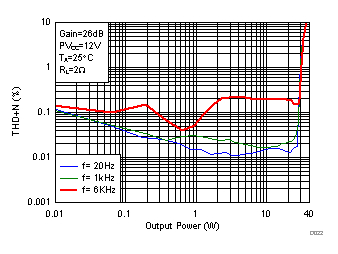 Figure 19. Total Harmonic Distortion + Noise (PBTL) vs Output Power
Figure 19. Total Harmonic Distortion + Noise (PBTL) vs Output Power
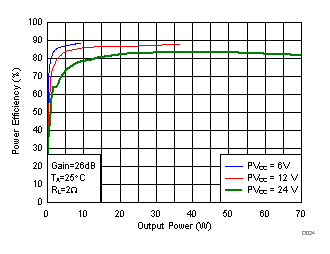 Figure 21. Power Efficiency (PBTL) vs Output Power
Figure 21. Power Efficiency (PBTL) vs Output Power
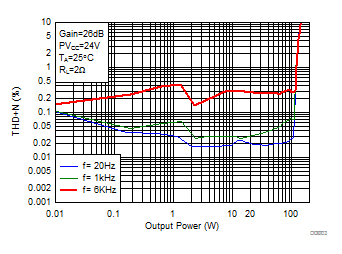 Figure 23. Total Harmonic Distortion + Noise (PBTL) vs Output Power
Figure 23. Total Harmonic Distortion + Noise (PBTL) vs Output Power
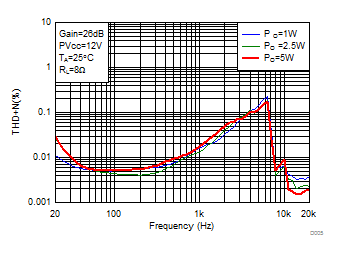 Figure 2. Total Harmonic Distortion + Noise (BTL) vs Frequency
Figure 2. Total Harmonic Distortion + Noise (BTL) vs Frequency
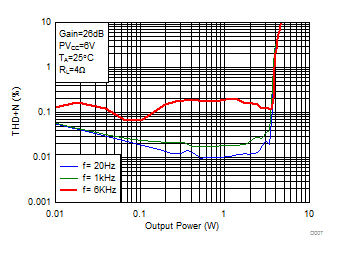 Figure 4. Total Harmonic Distortion + Noise (BTL) vs Output Power
Figure 4. Total Harmonic Distortion + Noise (BTL) vs Output Power
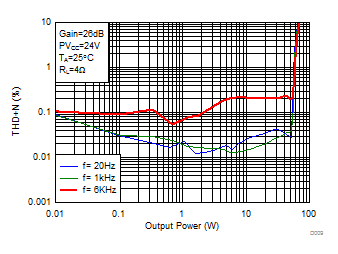 Figure 6. Total Harmonic Distortion + Noise (BTL) vs Output Power
Figure 6. Total Harmonic Distortion + Noise (BTL) vs Output Power
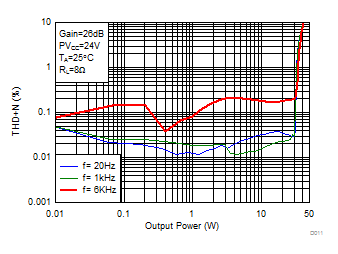 Figure 8. Total Harmonic Distortion + Noise (BTL) vs Output Power
Figure 8. Total Harmonic Distortion + Noise (BTL) vs Output Power
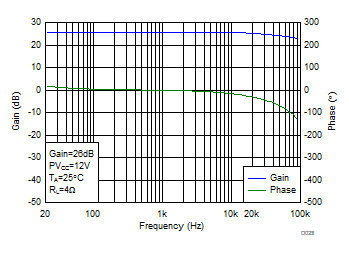 Figure 10. Gain/Phase (BTL) vs Frequency
Figure 10. Gain/Phase (BTL) vs Frequency
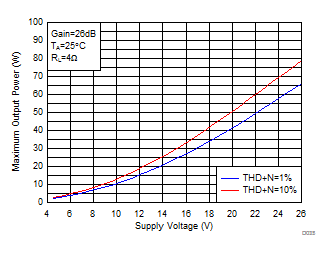 Figure 12. Maximum Output Power (BTL) vs Supply Voltage
Figure 12. Maximum Output Power (BTL) vs Supply Voltage
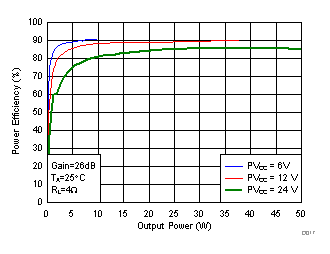 Figure 14. Power Efficiency (BTL) vs Output Power
Figure 14. Power Efficiency (BTL) vs Output Power
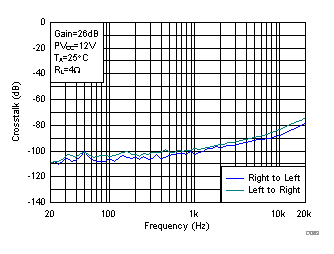 Figure 16. Crosstalk vs Frequency
Figure 16. Crosstalk vs Frequency
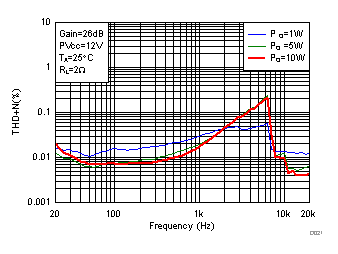 Figure 18. Total Harmonic Distortion + Noise (PBTL) vs Frequency
Figure 18. Total Harmonic Distortion + Noise (PBTL) vs Frequency
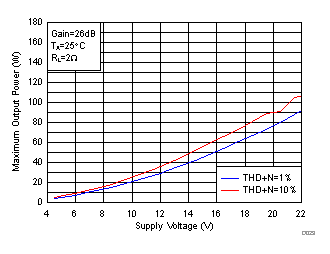 Figure 20. Maximum Output Power (PBTL) vs Supply Voltage
Figure 20. Maximum Output Power (PBTL) vs Supply Voltage
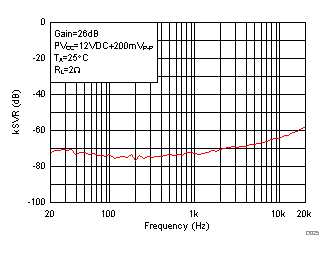 Figure 22. Supply Ripple Rejection Ratio (PBTL) vs Frequency
Figure 22. Supply Ripple Rejection Ratio (PBTL) vs Frequency
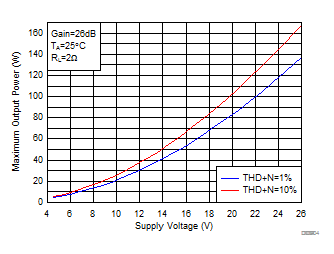 Figure 24. Maximum Output Power (PBTL) vs Supply Voltage
Figure 24. Maximum Output Power (PBTL) vs Supply Voltage